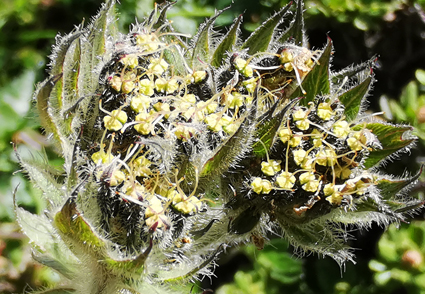Abstract
Tordyliopsis is a monotypic genus within the family Apiaceae and is endemic to the southern margin of the Himalayas. The type species, Tordyliopsis brunonis, is easily distinguished by its lanceolate bracts and bracteoles. In this study, we used both phylogenetic and morphological analyses to investigate the relationship between T. brunonis and other species in the Apiaceae. Our phylogenetic analyses of ITS sequences and 79 coding sequences from complete plastid genomes revealed that T. brunonis is nested with Semenovia species. Additionally, our morphological analysis showed that Tordyliopsis and Semenovia share several similar features, including elliptic or oblong mericarps with widely spaced dorsal ribs, broader and winged marginal ribs with slightly inflated distal parts, clavate vittae, and domed stylopodium. Based on these results, we propose that the monotypic genus Tordyliopsis should be transferred to Semenovia.
References
<p>Akaike, H. (1974) A new look at the statistical model identication. IEEE Transactions on Automatic Control 19: 716–723. https://doi.org/10.1109/TAC.1974.1100705<br>Altınordu, F., Peruzzi, L., Yu, Y. & He, X.J. (2016) A tool for the analysis of chromosomes: KaryoType. Taxon 65: 586–592. https://doi.org/10.12705/653.9<br>Burland, T.G. (2000) DNASTAR’s lasergene sequence analysis software. Methods in Molecular Biology 132: 71–91. https://doi.org/10.1385/1-59259-192-2:71<br>Cannon, J.F.M. (1978) Umbelliferae. In: Hara, H. & Williams, L.H.J. (eds.) Enumeration of the flowering plants of Nepal. London, pp. 184–190.<br>Chen, S., Zhou, Y.Q., Chen, Y.R. & Gu, J. (2018) Fastp: An ultra-fast all-in-one FASTQ preprocessor. Bioinformatics 34: i884–i890. https://doi.org/10.1093/bioinformatics/bty560<br>Clarke, C.B. (1879) Umbelliferae. In: Hooker, J.D. (ed.) Flora of British India, London, pp. 665–720.<br>De Candolle, A.P. (1830) Umbelliferae. In: De Candolle, A.P. (ed.) Prodromus systematis naturalis regni vegetabilis, Paris, etc., pp. 55–250.<br>Dierckxsens, N., Mardulyn, P. & Smits, G. (2017) NOVOPlasty: De novo assembly of organelle genomes from whole genome data. Nucleic Acids Research 4: e18. https://doi.org/10.1093/nar/gkw955<br>Drude, O. (1898) Umbelliferae. In: Engler, A. & Prantl, H. (eds.) Die natürlichen Pflanzenfamilien, vol. 3. Leipzig, pp. 63–271.<br>Paik, J.H. (2009) Systematic studies of Heracleum L. (Umbelliferae) and related genera in the Sino-Himalayan region. Dissertation, University of Edinburgh.<br>Hoang, D.T., Chernomor, O., Haeseler, A.V., Minh, B.Q. & Vinh, L.S. (2017) UFBoot2: Improving the ultrafast bootstrap approximation. Molecular Biology and Evolution 35: 518–522. https://doi.org/10.1093/molbev/msx281<br>Kalyaanamoorthy, S., Minh, B.Q., Wong, T.K.F., Haeseler, A.V. & Jermiin, L.S. (2017) ModelFinder: Fast model selection for accurate phylogenetic estimates. Nature Methods 14: 587–589. https://doi.org/10.1038/nmeth.4285<br>Katoh, K. & Standley, D.M. (2013) MAFFT Multiple sequence alignment software version 7: improvements in performance and usability. Molecular Biology and Evolution 30: 772–780. https://doi.org/10.1093/molbev/mst010<br>Kearse, M., Moir, R., Wilson, A., Stones-Havas, S., Cheung, M., Sturrock, S., Buxton, S., Cooper, A., Markowitz, S., Duran, C., Thierer, T., Ashton, B., Meintjes, P. & Drummond, A. (2012) Geneious Basic: An integrated and extendable desktop software platform for the organization and analysis of sequence data. Bioinformatics 28: 1647–1649. https://doi.org/10.1093/bioinformatics/bts199<br>Linnaeus, C. (1753) Species plantarum 1. Holmiae, Impensis Laurentii Salvii, 249 pp. <br>Mandenova, I.P. (1959) Materialy ksistematike triby Pastinaceae K.-Pol. emend. Manden. (Umbelliferae-Apioideae). Trudy Tbilisskogo Botanicheskogo Instituta 20: 3–57.<br>Mukherjee, P.K. (1978) A resume of Indian umbellifers. In: Cauwet-Marc, A.M. & Carbonnier, J. (eds.) Actes 2e Symp. Intern. Ombellifères (Perpignan), Univ. de Perpignan, pp. 47–70.<br>Mukherjee, P.K. & Constance, L. (1993) Umbelliferae (Apiaceae) of India. New Delhi, etc.<br>Pimenov, M.G., Kljuykov, E.V., Dickoré, W.B. & Miehe, G. (2000) Four Himalayan Umbelliferae new to the Flora of China, with critical notes on Tordyliopsis DC. and Keraymonia Farille. Willdenowia 30: 361–367. https://doi.org/10.3372/wi.30.30213<br>Pimenov, M.G. (2017) Updated checklist of Chinese Umbelliferae: nomenclature, synonymy, typication, distribution. Turczaninowia 20: 106–239. https://doi.org/10.14258/turczaninowia.20.2.9<br>Pu, F.D. & Watson, M.F. (2005) Apiaceae (Umbelliferae). In: Wu, Z.Y. & Raven, R.H. (Eds.) Flora of China (Apiaceae through Ericaceae). Missouri Botanical garden Press, Beijing: Science Press & St. Louis, pp. 1–205.<br>Qu, X.J., Moore, M.J., Li, D.Z. & Yi, T.S. (2019) PGA: A software package for rapid, accurate, and flexible batch annotation of plastomes. Plant Methods 15: 50. https://doi.org/10.1186/s13007-019-0435-7<br>Regel, E. & Herder, F. (1866) Enumeratio plantarum in regionibus cis- et transiliensibus a cl. Semenowio anno 1857 collectarum. Bulletin de la Socieìteì impeìriale des naturalistes de Moscou 39: 527–571. <br>Ronquist, F., Teslenko, M., van der Mark, P., Ayres, D.L., Darling, A., Höhna, S., Larget, B., Liu, L., Suchard, M.A. & Huelsenbeck, J.P. (2012) MrBayes 3.2: Efficient Bayesian phylogenetic inference and model choice across a large model space. Systematic Biology 61: 539–542. https://doi.org/10.1093/sysbio/sys029<br>Watson, M.F. (1998) Notes relating to the flora of Bhutan: XXXIII. Umbelliferae, I. Edinburgh Journal of Botany 53: 127–144.<br>Watson, M.F. (1999) Umbelliferae. In: Grierson, A.J.C. & Long, D.G. (eds.) Flora of Bhutan. Edinburgh, pp. 434–504.<br>White, T.J., Bruns, T., Lee, S. & Taylor, J. (1990) Amplification and direct sequencing of fungal ribosomal RNA genes for phylogenetics. In: Innis, M.A., Gelfand, D.H. & Sninsky, J.J. (eds.) PCR Protocols: A guide to methods and applications. Academic, New York, pp. 315–322. https://doi.org/10.1016/B978-0-12-372180-8.50042-1<br>Xiao, Q.Y. (2017) Phylogeny of subtribe Tordyliinae (Apiaceae tribe Tordylieae) in China. Dissertation, Sichuan University.<br>Xiao, Q.Y., Hu, H.Y., Tong, F., Li, M.J. & He, X.J. (2017) Semenovia torilifolia is conspecific with S. Malcolmii (Apiaceae) based on morphology and molecular data. Phytotaxa 321: 225–237. https://doi.org/10.11646/phytotaxa.321.3.1</p>


